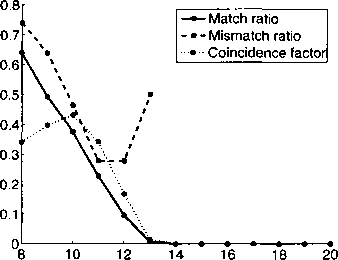Total Accuracy of Simulations, 250 strong inputs
0.8
0.7
0.6
Match ratio
- ∙ - Mismatch ratio
■ Coincidence factor

Voltage threshold from rest (mV)
Total Accuracy of Simulations, 1250 weak inputs

Voltage threshold from rest (mV)
Figure 2.14: Ratio of matched and mismatched spikes, as well as the coincidence factor, as ½∣-,
increases for A) 250 “strong” inputs and B) 1250 “weak” inputs per simulation. For each Vth value
we used τref = 4 ms and ran at least 20 simulations of 1000 ms with alpha-function synaptic inputs
to random locations. Ratios are given for the match and mismatch values rather than percentages
for ease of comparison with Γ.
53
the weak ones, which agrees with typical values in Chapter 3 of (Traub and Miles,
1991) and (Thomson and Lamy, 2007).
As shown in Figure 2.14, low thresholds capture a large number of the nonlinear
spikes, but also yield more mismatched spikes. Fewer mismatched spikes occur as V⅛
increases, but this also leads to greatly diminished numbers of spikes generated, and
hence fewer nonlinear spikes captured. More mismatched spikes were observed in the
“weak” input simulations, but more spikes were matched as well. The coincidence
factors were also low for these simulations, reaching a peak of 0.43 at ½ι, = 10 mV
for the “weak” input case and a peak of 0.52 at ½h = 8 mV for the “strong” input
case.
The spike data is shown explicitly in the soma potentials of Figure 2.15. It is
evident from these plots that the reduced system captures the subthreshold behaviors
very well even for large depolarizations. Furthermore, the spike times computed by
More intriguing information
1. MULTIPLE COMPARISONS WITH THE BEST: BAYESIAN PRECISION MEASURES OF EFFICIENCY RANKINGS2. APPLICATIONS OF DUALITY THEORY TO AGRICULTURE
3. The Clustering of Financial Services in London*
4. The name is absent
5. Hemmnisse für die Vernetzungen von Wissenschaft und Wirtschaft abbauen
6. The name is absent
7. The name is absent
8. Aktive Klienten - Aktive Politik? (Wie) Läßt sich dauerhafte Unabhängigkeit von Sozialhilfe erreichen? Ein Literaturbericht
9. Pupils’ attitudes towards art teaching in primary school: an evaluation tool
10. The name is absent